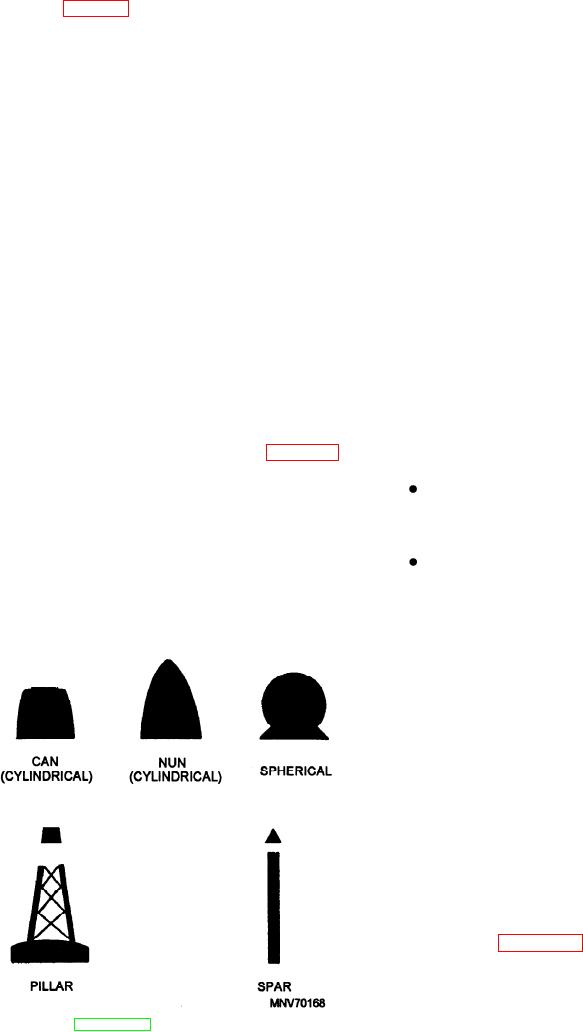
Topmarks
system. (See fig. 6-13.) This agreement was sponsored
by the International Association of Lighthouse
Topmarks are small shapes placed on top of some
Authorities (IALA) and bears its name.
lighted buoys to aid in daytime identification. The
The IALA Maritime Buoyage System provides
IALA Maritime Buoyage System uses can, nun,
rules that apply to all fixed and floating markers other
spherical, and X-shaped topmarks only. Topmarks on
than lighthouses, sector lights, range lights, lightships,
pillar and spar buoys are particularly important to
and large automatic navigational buoys (lanbys).
indicate the side on which they will be passed and will
BUOYS
be used, wherever practical.
Buoys have various sizes and shapes; however, they
Lights
have distinctive coloring, shapes, and topmarks to
indicate their purpose by day and colored lights with
Where marks are lighted, red and green lights are
specific phase characteristics by night.
reserved for port and starboard or starboard and port
Although buoys are valuable aids to navigation,
lateral marks. Yellow lights are for special marks, and
you must never depend on them exclusively. Buoys
white lights are used for other types of marks, which we
frequently drag their moorings in heavy weather or may
will discuss later in this chapter.
be set adrift if run down by passing vessels. Lights on
lighted buoys may go out of commission. Whistles,
LATERAL MARKS
bells, and gongs actuated by the motion of the sea may
fail to function in smooth water.
Lateral marks are generally used for well-defined
channels. They indicate the route to be followed and are
Buoy Shape
used in conjunction with a "conventional direction of
There are five basic buoy shapes (fig. 6-14);
buoyage." This directionis defined in one of two ways:
namely, can, nun, spherical, pillar, and spat: With the
Local direction of buoyage--the direction the
exception of pillar and spar buoys, the shape of the buoy
mariner should take when approaching a harbor,
indicates the correct side on which to pass. Can buoys
river estuary, or other waterway from seaward.
may sometimes be referred to as cylindrical, and nun
buoys may be referred to as conical. The term pillar is
General direction of buoyage--in other areas, a
used to describe any buoy that is smaller than a
direction determined by the buoyage authorities,
lighthouse buoy and has a tall, central structure on a
following a clockwise direction around
broad base. Lighted buoys in the United States are
continental landmasses, given in Sailing
referred to as pillar buoys.
Directions, and, if necessary, indicated on charts
by a symbol.
feature. In the United States, fairway and channel buoys
are always numbered odd to port and even to starboard,
approaching from seaward.
BUOYAGE REGIONS
As we mentioned previously, two International
Buoyage Regions were established under IALA.
Navigational charts produced and printed after 1983
indicate the buoyage region to which a chart refers.
Lateral Marks Used in Region A
As shown in figure 6-13, International Buoyage
Region A covers Europe and Asia with the exception of
Japan, the Republic of Korea, and the Republic of the
Philippines. The major rule to remember in this region
is "red to port" when you are returning from seaward.
Figure 6-14.--Types of buoys.
6-15

